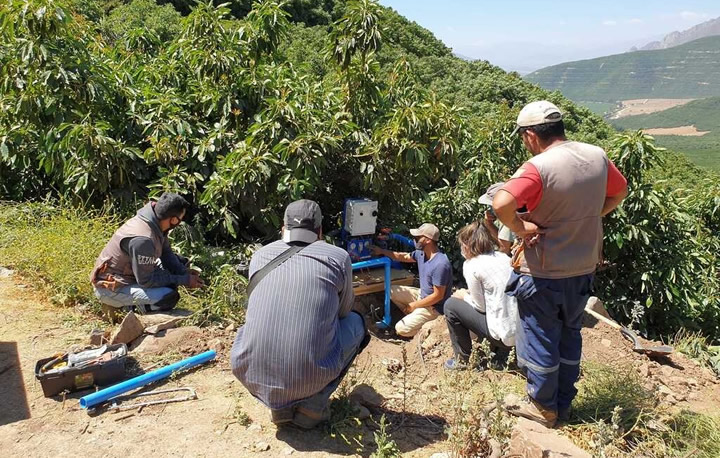Avocados: Better Crop Quality and 40% Production Increase with Nanobubble-Infused Irrigation Water

Avocados have long been, and still are, in high demand around the world. The U.S. is a major importer of the nutritious tree fruit, which possesses both high demand and production in Latin America as well.[1] Europe is another rapidly developing market for the avocado, which is forecasted to be the most-traded tropical fruit in the world by 2030, after the banana.[2] For Latin American countries, which are well-suited to growing avocado trees thanks to their climate, this makes for a great window of opportunity for farmers.
Production Challenges
Avocado growers face many challenges, particularly in irrigation. Unlike most plants, avocado trees’ root zone is situated close to the surface of the soil and needs to be continuously irrigated to fight drought conditions and develop healthy roots.[3] Avocado tree roots are highly susceptible to anoxia, or the absence of oxygen, which is often caused by waterlogging from overwatering. Care should be taken not to overwater or underwater, both of which can lead to root damage.[4]
Healthy Roots Need Dissolved Oxygen
To prevent water from flooding the root zone, it's imperative to supply avocado trees with enough dissolved oxygen so they can absorb the water efficiently. The benefits of root zone oxygenation are well-established: avocado growers knew of the beneficial effects since the 1940s.[5]
Soil Waterlogging Hurts Root Development
Soils with high amounts of clay particles have high water holding capacity, meaning that water is held close to the soil particles for longer than soils with high sand content. Additionally, soils with a high amount of clay can have compaction issues, reducing water infiltration to the root zone. Both can lead to waterlogging in soil. To combat this, growers should improve the structure of the soil to increase infiltration rates and reduce waterlogging and practice good irrigation practices.
Nanobubbles Improve Water and Nutrient Absorption
Preventing waterlogging is essential in the successful cultivation of avocado trees. Moleaer generators produce nanobubbles that help combat soil compaction through increased soil flocculation and contribute to more efficient absorption of water and nutrients by the plant. To demonstrate the positive impact from nanobubbles, a trial was carried out by GAMA, a Chilean research and consultancy company.
Improved Plant vigor
The trial was conducted over a 12-month period, with nanobubbles, generated by a Moleaer XTB 50, injected inline into the irrigation system. The researchers found significant improvement in plant vigor, good postharvest parameters, and lower soil compaction. These findings are corroborated by improved production numbers.
40% production increase of high caliber fruit
Compared to the control group, avocado trees treated with nanobubbles showed significantly higher production. The total production increase in nanobubble-treated avocado trees versus untreated trees was 6 percent over the course of the trial. When looking at calibers of 50 and over, the difference is even more striking: in avocados of 199 grams and more, the production from nanobubble-treated trees was 40 percent higher than that of untreated trees. This clearly demonstrates the positive effects of nanobubbles on avocado production.
About Moleaer
Moleaer™ is the global leader in nanobubble technology with a mission to do more using less water. By deploying the power of nanobubbles, the company enhances and improves the performance and productivity of many of the world’s most critical industrial processes. Its proprietary nanobubble technology unlocks the power of water to help farmers grow more food, empowers businesses to manage water more effectively and efficiently, and restores aquatic ecosystems sustainably without chemicals.
Moleaer has deployed more than 1,500 nanobubble generator installations in more than 30 countries. The generators inject nanobubbles ― 2,500 times smaller than a grain of salt ― that supersaturate the water with oxygen or other gases, form mild oxidants for disinfection, and increase water’s ability to permeate soil and rock. Moleaer’s patented nanobubble technology provides the highest oxygen transfer rate in the industry at >85% and is a cost-effective, chemical-free solution proven to increase sustainable food production through better plant health and heat tolerance, reduce the use of chemicals across water-based industrial processes including the food value chain, restore aquatic ecosystems, and improve natural resource recovery.
To learn more, visit: www.Moleaer.com
[1] https://research.rabobank.com/far/en/sectors/fresh-produce/plenty-of-avocado-advocates-around-the-world.html
[2] https://www.cbi.eu/market-information/fresh-fruit-vegetables/avocados/market-potential
[3] https://www.californiaavocadogrowers.com/sites/default/files/documents/Irrigating-Avocados-Fact-Sheet.pdf
[4] https://www.agric.wa.gov.au/spring/growing-avocados-irrigation-principles?page=0%2C4
[5] http://avocadosource.com/CAS_Yearbooks/CAS_25_1940/CAS_1940_PG_77-84.pdf
Comments (0)
This post does not have any comments. Be the first to leave a comment below.
Featured Product

